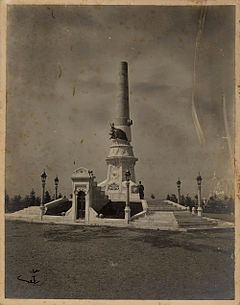Type memorial and cemetery Completion date 23 July 1911 | Material marble Beginning date 1909 Designer Mimar Muzaffer Bey | |
 | ||
Dedicated to Soldiers killed during the 31 March Incident in 1909 Similar Atatürk Museum - Şişli, Dolmabahçe Clock Tower, Ahrida Synagogue of Istanbul, Valens Aqueduct, Caferağa Medresseh | ||
The Monument of Liberty or Monument of Eternal Liberty (Turkish: Hürriyet Anıtı; Ottoman Turkish: Abide-i Hürriyet), located in the Şişli district of Istanbul, Turkey, is a memorial in honor of the soldiers killed defending the Ottoman parliament against reactionary monarchist forces during the 1909 countercoup, most notably in the 31 March Incident.
Contents
The Tanzimat reforms, which began in 1839, along with other subsequent liberalization processes, were strongly opposed by conservatives in the Ottoman Empire. They hoped to re-affirm the monarchic powers of the Sultan Abdulhamid II as absolute monarch, even though the Sultan himself came to power accepting a Constitution and opening the first Ottoman parliament, the General Assembly of the Ottoman Empire, in 1876 during the First Constitutional Era. Parliament was adjourned in 1878 with the pretext of the Russian War and Abdulhamid II reigned as an absolute monarch for over 30 years until 1908, when Parliament resumed its activities in the Second Constitutional Era, upon pressure of the progressive forces in the Empire. However, a reactionary uprising that began on April 13, 1909 (March 31, 1325 AH in Rumi calendar) caused the democratic process to be interrupted once again. Progressive forces of the "Hareket Ordusu" (Turkish for "Army of Action") that came from the Rumelia, under the command of Mahmud Șevked Pasha, suppressed the countercoup on July 23, 1909. Abdulhamid II was deposed by the Committee of Union and Progress, the foremost constitutionalist party, and sent to exile in Salonica, then part of the Ottoman Empire.
The monument was inaugurated in 1911, at the second anniversary of the 31 March Incident. The complex also holds the graves of four notable Ottoman high-ranked officials, which were moved here in a later time. The monument, seen today as a symbol of modernity, democracy, and secularism in Turkey, serves as a place of some official ceremonies and public gatherings.
Design
The monument is situated on the highest hill (130 m (430 ft) above the sea level) in Şişli, Istanbul, called "Hürriyet-i Ebediye Tepesi" (literally Eternal Liberty Hill) and lies today within a triangular area bordered by three major highways between Şişli and Çağlayan.
It was designed by the renowned Ottoman architect Muzaffer Bey, who won the related architectural contest. The monument, constructed between 1909 and 1911 in the form of a cannon firing in the sky, is erected on an equilateral triangular base. On each side of the marble base, the names of the soldiers resting below are carved. On the monument, the tughra of Sultan Mehmed V Reşat is put on. It is situated in the center of a park with pathways like a pentagon star surrounded by a circle symbolizing the star and crescent in the Ottoman flag.
Burials
At the monument, the 74 soldiers killed in action of the 31 March Incident were initially buried with a state ceremony on July 23, 1911.
Remains of the below four high-ranking officials of the Ottoman Empire were buried here later on as well:
Meeting point
The place serves as the meeting point for democracy and civil rights demonstrations in Istanbul. Labour Day demonstrations organized by trade unions were celebrated around this place many years long following the Taksim Square massacre in 1977.
The second mass rally of the Republic Protests against the presidential election took place here on April 29, 2007.
Logo of Şişli district
The view of the monument is contained in the logo of Şişli Municipality used by the district mayor.
